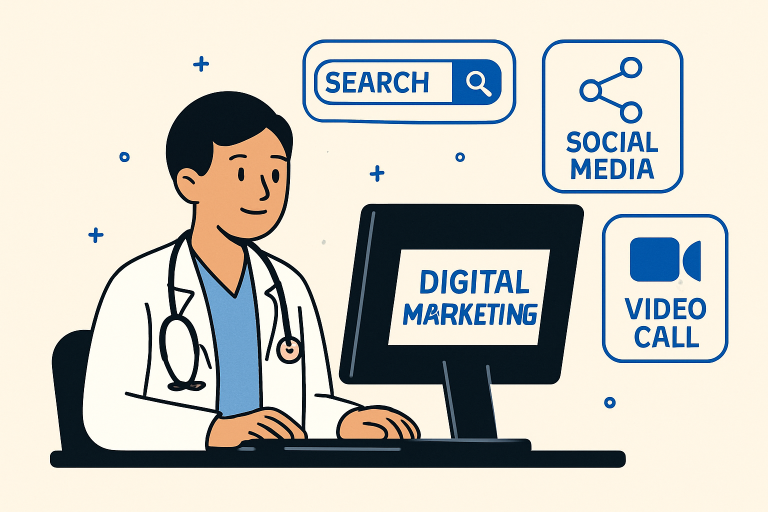
Introduction
As patient behaviors shift and digital channels grow in importance, healthcare providers are rapidly embracing digital marketing to drive practice growth and patient volume. Strategic online approaches can dramatically enhance patient acquisition, enabling medical organizations to reach more prospective patients, foster engagement, and build a stronger reputation in their market. By focusing on the right patient acquisition marketing strategies, healthcare practices can deliver more value while responding to how today’s patients search for care.
With more individuals researching medical treatments, conditions, and providers through digital touchpoints, optimizing your marketing efforts for this environment is non-negotiable. Providers who tap into these opportunities position themselves as empathetic, accessible, and trustworthy. They cement their place as go-to experts for digital-first patients empowered to make informed choices.
Optimizing Your Website for Search Engines
For most patients, the digital journey starts at the search bar. That’s why a well-optimized website is the backbone of modern healthcare marketing. By employing medical SEO best practices, practices can climb search engine rankings, standing out when people investigate symptoms, treatments, or providers. Effective SEO integrates user-friendly navigation, robust security, and mobile responsiveness—critical credibility factors for health consumers.
- Keyword Research: Identify search terms patients use, including condition-specific or location-based phrases.
- On-page Optimization: Enhance meta titles and descriptions, use logical header tags, and ensure accurate schema markup for better local search performance.
- Quality Backlinks: Secure citations and links from reputable medical directories, professional associations, and local business groups to boost domain authority.
Regular site updates, a secure SSL certificate, and clear paths to request appointments not only please search engines but also reassure human visitors.
Leveraging Social Media Platforms
Modern patient acquisition thrives in the social sphere. Platforms like Facebook, Instagram, and LinkedIn provide dynamic avenues for healthcare organizations to reach patients where they spend time and seek medical advice. Posting engaging content—such as wellness tips, office updates, or patient stories—builds trust and strengthens bonds.
Replying promptly to questions on social media, running live Q&As, and encouraging feedback create a sense of community and transparency. Consistency is key: a steady cadence of high-value posts ensures your practice stays top-of-mind.
Implementing Pay-Per-Click (PPC) Advertising
PPC campaigns, including Google Ads and paid social promotion, can turbocharge patient acquisition by targeting relevant demographics and search queries. Unlike organic methods, PPC delivers immediate visibility right when users are most likely to take action. Healthcare providers should develop campaigns around procedures, specialties, or specific health needs in their market.
With clear calls-to-action and tailored landing pages, PPC efforts can yield high conversion rates and a measurable return on ad spend. Advanced targeting lets you prioritize your budget for the highest-value prospects, maximizing efficiency and impact.
Utilizing Content Marketing
Educational content builds authority, trust, and organic reach. Your practice positions itself as a helpful resource by publishing blog posts, articles, or explainer videos about common conditions, preventive care, or treatment guidance. Content marketing also deepens your SEO footprint, driving more visitors from search engines.
High-performing healthcare content answers patient questions, addresses anxieties, and demystifies services. Regularly updated FAQs, downloadable guides, and physician-written articles signal credibility and expertise, increasing the likelihood that patients will choose your clinic when seeking care.
Embracing Telemedicine and Virtual Consultations
Telemedicine is no longer just a trend—it’s a patient expectation. Promoting virtual services through your site and digital channels extends your reach to those who value convenience or live further afield. Highlighting the simplicity, safety, and accessibility of virtual care distinguishes your practice as forward-thinking.
Implement clear instructions for booking and participating in video visits. When patients perceive telemedicine as secure, easy, and beneficial, your practice becomes the natural choice for remote and local audiences.
Personalizing Patient Communication
In digital health marketing, one-size-fits-all messages are quickly left behind. Today’s tools enable deep personalization, such as sending tailored emails featuring relevant conditions, reminders for overdue screenings, or invitations to practice events. Leveraging data—while respecting privacy—helps you connect meaningfully with every segment of your patient base.
For instance, segmenting lists by age, interests, or insurance type improves open rates and response. Personalized appointment reminders or wellness tips build loyalty and show patients you care about their individual needs, not just their next visit.
Monitoring and Analyzing Performance
Review analytics from your website, social campaigns, and paid ads regularly to ensure long-term success. Platforms like Google Analytics reveal which channels drive the most traffic and conversions, letting you adjust strategies for better results. Track metrics such as click-through rates, cost per acquisition, and patient retention so you can continually fine-tune efforts.
Emphasizing data-driven decisions keeps your acquisition strategy agile, efficient, and customer-focused.
Final Thoughts
Healthcare providers can achieve transformative gains in attracting, engaging, and retaining patients by integrating digital marketing into every facet of patient outreach. From optimizing web presence and leveraging social communities to delivering personalized communications and harnessing powerful analytics, today’s digital tools provide a strategic advantage in pursuing sustainable growth. Adopting these approaches ensures your practice stands out in the digital age—ready to serve, connect, and thrive.